Mybtis核心学习
Mybatis
1、简介
1.1、Mybaits简介
MyBatis 是一款优秀的持久层框架,它支持自定义 SQL、存储过程以及高级映射。MyBatis 免除了几乎所有的 JDBC 代码以及设置参数和获取结果集的工作。MyBatis 可以通过简单的 XML 或注解来配置和映射原始类型、接口和 Java POJO(Plain Old Java Objects,普通老式 Java 对象)为数据库中的记录。
1.2、持久化
数据持久化
- 持久化就是将程序员的数据在持久状态和瞬时状态转化的过程
- 内存:断电即失
- 数据库(JDBC),IO持久化
为什么需要持久化?
- 有一些对象,不能让他丢掉
1.3、持久层
Dao层,Servlet层、Controller层、、、
- 完成持久化工作的代码块
- 层是界限十分明显的
1.4、为什么需要使用Mybatis?
- 方便
- 传统的JDBC代码太复杂了,简化。框架
2、第一个Mybaits程序
2.2、搭建数据库
2.2、创建一个模块
-
编写mybatis的核心配置文件
<?xml version="1.0" encoding="UTF-8" ?> <!DOCTYPE configuration PUBLIC "-//mybatis.org//DTD Config 3.0//EN" "http://mybatis.org/dtd/mybatis-3-config.dtd"> <!--核心配置文件--> <configuration> <environments default="development"> <environment id="development"> <transactionManager type="JDBC"/> <dataSource type="POOLED"> <property name="driver" value="com.mysql.jdbc.Driver"/> <property name="url" value="jdbc:mysql://localhost:3306/mybatis?useSSL=true&useUnicode=true&characterEncoding=utf-8"/> <property name="username" value="root"/> <property name="password" value="123456"/> </dataSource> </environment> </environments> <mappers> <mapper resource="org/mybatis/example/BlogMapper.xml"/> </mappers> </configuration> -
编写mybatis工具类
public class MybatisUtils {
private static SqlSessionFactory sqlSessionFactory = null;
static {
//获取sqlSessionFactory
String resource = "mybatis-config.xml";
InputStream inputStream = null;
try {
inputStream = Resources.getResourceAsStream(resource);
sqlSessionFactory = new SqlSessionFactoryBuilder().build(inputStream);
} catch (IOException e) {
e.printStackTrace();
}
}
public static SqlSession getSqlSession() {
return sqlSessionFactory.openSession();
}
}
2.3、编写代码
-
实体类
-
Dao接口
public interface UserDao { List<User> getUserList(); } -
接口实现类
<?xml version="1.0" encoding="UTF-8" ?> <!DOCTYPE mapper PUBLIC "-//mybatis.org//DTD Mapper 3.0//EN" "http://mybatis.org/dtd/mybatis-3-mapper.dtd"> <!--namespace=绑定一个对应的Mapper接口--> <mapper namespace="com.bing.dao.UserDao"> <!-- select查询语句 --> <select id="getUserList" resultType="com.bing.pojo.User" > select * from mybatis.user </select> </mapper>
2.4、测试
注意
org.apache.ibatis.binding.BindingException: Type interface com.bing.dao.Mapper is not known to the MapperRegistry.
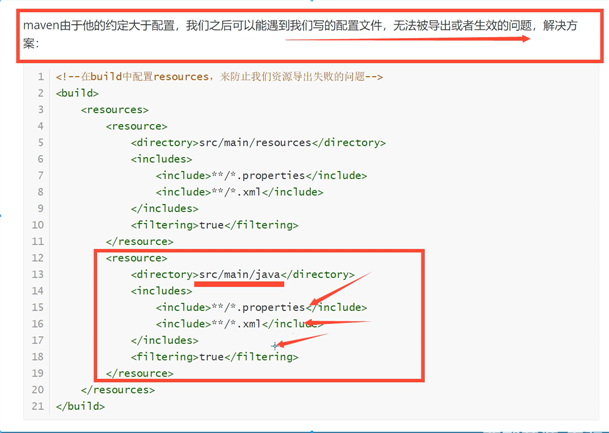
<build>
<resources>
<resource>
<directory>src/main/resources</directory>
<includes>
<include>**/*.properties</include>
<include>**/*.xml</include>
</includes>
<filtering>true</filtering>
</resource>
<resource>
<directory>src/main/java</directory>
<includes>
<include>**/*.properties</include>
<include>**/*.xml</include>
</includes>
<filtering>true</filtering>
</resource>
</resources>
</build>
3、CRUD
1、select
<select id="getUserList" resultType="com.bing.pojo.User">
select *
from mybatis.user
</select>
<select id="getUserById" resultType="com.bing.pojo.User" parameterType="int">
select *
from mybatis.user
where id = #{id}
</select>
2、insert
<insert id="addUser" parameterType="com.bing.pojo.User">
insert into mybatis.user (id, name, pwd)
values (#{id}, #{name}, #{pwd});
</insert>
3、update
<update id="updateUser" parameterType="com.bing.pojo.User">
update mybatis.user
set name = #{name},
pwd=#{pwd}
where id = #{id};
</update>
4、delete
<delete id="deleteUser" parameterType="com.bing.pojo.User">
delete
from mybatis.user
where id = #{id}
</delete>
注意点:增删改需要提交事务
5、万能Map
int getUserById2(Map<String, Object> map);
@Test
public void inseMap() {
SqlSession sqlSession = MybatisUtils.getSqlSession();
UserMapper mapper = sqlSession.getMapper(UserMapper.class);
Map<String, Object> map = new HashMap<String, Object>();
map.put("userid", 6);
map.put("username", "98");
mapper.getUserById2(map);
sqlSession.commit();
sqlSession.close();
}
<insert id="getUserById2" parameterType="map">
insert into mybatis.user (id, name, pwd)
values (#{userid}, #{username}, #{password});
</insert>
6、模糊查询
1、Java代码执行的时候,传递通配符% %
List<User> userList = mapper.getUserLike("%张%");
2、在sql拼接字符串
where name LIKE "%"#{value }"%"
4、配置解析
1、核心配置文件
-
mybatis-config.xml
configuration(配置)
- properties(属性)
- settings(设置)
- typeAliases(类型别名)
- typeHandlers(类型处理器)
- objectFactory(对象工厂)
- plugins(插件)
- environments(环境配置)
- environment(环境变量)
- transactionManager(事务管理器)
- dataSource(数据源)
- databaseIdProvider(数据库厂商标识)
- mappers(映射器)
2、环境配置(environments)
MyBatis 可以配置成适应多种环境
掌握
Mybatis默认是事务管理器是JDBC 连接池:POOLED
3、属性(properties)
我们可以通过properties属性来实现引用配置文件
这些属性可以在外部进行配置,并可以进行动态替换。你既可以在典型的 Java 属性文件中配置这些属性,也可以在 properties 元素的子元素中设置【db.properties】
编写一个配置文件
db.properties
driver=com.mysql.jdbc.Driver
url=jdbc:mysql://localhost:3306/mybatis?useSSL=true&useUnicode=true&characterEncoding=utf-8
username=root
password=123456
在核心文件引入映射
<!-- 引入外部配置文件-->
<properties resource="db.properties">
<property name="username" value="root"/>
<property name="password" value="123456"/>
</properties>
- 可以直接引入外部文件
- 可以在其中增加一些属性配置
- 如果两个文件有同一个字段,优先使用外部配置文件
4、类型别名(typeAliases)
类型别名可为 Java 类型设置一个缩写名字。 它仅用于 XML 配置,意在降低冗余的全限定类名书写。
<!-- 可以给实体类起别名-->
<typeAliases>
<typeAlias type="com.bing.pojo.User" alias="User"/>
</typeAliases>
也可以指定一个包名,MyBatis 会在包名下面搜索需要的 Java Bean
在扫描实体类的包,它的默认别名是这个类名的首字母的小写
<!-- 可以给实体类起别名-->
<typeAliases>
<package name="com.bing.pojo"/>
</typeAliases>
注解别名
@Alias("user")
public class User
5、设置(settings)
这是 MyBatis 中极为重要的调整设置,它们会改变 MyBatis 的运行时行为。


6、其他配置
- typeHandlers(类型处理器)
- objectFactory(对象工厂)
- plugins(插件)
- mybatis-plus
- 通用mapper
7、映射器(mappers)
Mapper
<mappers>
<mapper resource="com/bing/dao/UserMapper.xml"/>
</mappers>
方式二使用class文件绑定注册
<mappers>
<mapper class="com.bing.dao.UserMapper"/>
</mappers>
注意点:
- 接口和它的Mapper配置文件必须同名
- 接口和它的Mapper配置文件必须同一个包下
方式三:使用扫描包
<mappers>
<package name="com.bing.dao"/>
</mappers>
8、生命周期和作用域
作用域 、生命周期类别是至关重要的,因为错误的使用会导致非常严重的并发问题。
SqlSessionFactoryBuilder
- 一旦创建了 SqlSessionFactory,就不再需要它了
- 局部变量
SqlSessionFactory
- SqlSessionFactory 一旦被创建就应该在应用的运行期间一直存在,没有任何理由丢弃它或重新创建另一个实例
- 最简单的就是使用单例模式或者静态单例模式。
- 因此 SqlSessionFactory 的最佳作用域是应用作用域
SqlSession
- SqlSession 的实例不是线程安全的,因此是不能被共享的,所以它的最佳的作用域是请求或方法作用域
- 用完一定记得关闭
5、解决属性名和字段名不一致的问题
数据库的字段
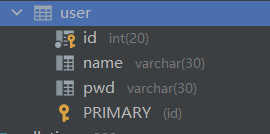
public class User {
private int id;
private String name;
private String password;
}

select * from mybatis.user where id = #{id}
解决方法:
-
起别名
<select id="getUserById" resultType="com.bing.pojo.User" parameterType="int"> select id,name,pwd as password from mybatis.user where id = #{id} </select> -
resultMap
-
结果集映射
-
id name pwd
id name password
-
<resultMap id="UserMap" type="User"> <!-- property数据库的字段 column实体类的属性--> <result column="id" property="id"/> <result column="name" property="name"/> <result column="pwd" property="password"/> </resultMap> <select id="getUserById" resultMap="UserMap"> select * from mybatis.user where id = #{id} </select> -
resultMap元素是 MyBatis 中最重要最强大的元素
-
6、日志
6.1、日志工厂
如果一个数据库操作,出现了异常,我们需要排错,日志就是最好的帮手

- SLF4J
- LOG4J
- LOG4J2
- JDK_LOGGING
- COMMONS_LOGGING
- STDOUT_LOGGING
- NO_LOGGING
标准的STDOUT_LOGGING 日志
<settings>
<setting name="logImpl" value="STDOUT_LOGGING"/>
</settings>
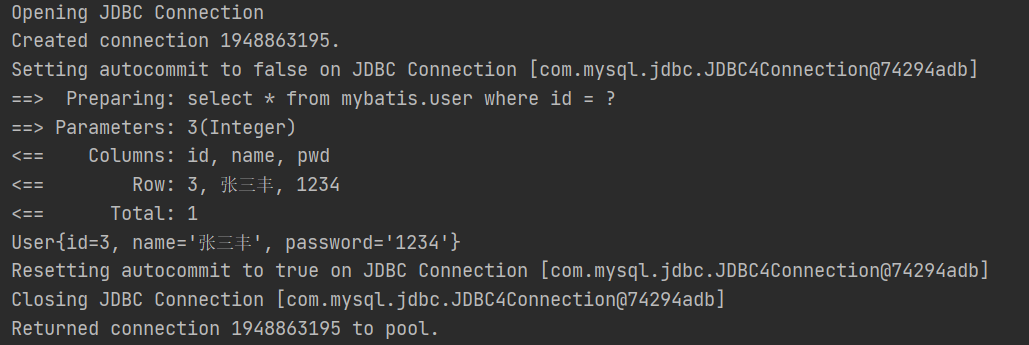
6.2、 LOG4J
什么是LOG4J?
- Log4j是Apache的一个开源项目,通过使用Log4j,我们可以控制日志信息输送的目的地是控制台
- 先导入 LOG4J 的包
<!-- https://mvnrepository.com/artifact/log4j/log4j -->
<dependency>
<groupId>log4j</groupId>
<artifactId>log4j</artifactId>
<version>1.2.17</version>
</dependency>
7、分页
为什么要分页?
- 减少数据的处理量,提高效率
7.1、使用Limit分页
语法 :select * from user limit startIndex,pageSize
接口
List<User> getUserLimit(Map<String, Integer> map);
Mapper.xml
<select id="getUserLimit" parameterType="map" resultMap="UserMap">
select *
from mybatis.user limit #{startIndex},#{pageSize}
7.2、RowBounds分页
接口
List<User> getUserRowBounds();
mapper.xml
<select id="getUserRowBounds" resultMap="UserMap">
select *
from mybatis.user
</select>
测试
@Test
public void getUserByRowBounds() {
SqlSession sqlSession = MybatisUtils.getSqlSession();
RowBounds rowBounds = new RowBounds(1, 2);
//通过java代码层面实现分页
List<User> userList = sqlSession.selectList("com.bing.dao.UserMapper.getUserRowBounds", null, rowBounds);
for (User user : userList) {
System.out.println(user);
}
}
8、使用注解开发
1、注解在接口上实现
@Select("select *from user")
List<User> getUsers();
2、在核心文件配置
<!--绑定接口-->
<mappers>
<mapper class="com.bing.dao.UserMapper"/>
</mappers>
3、测试
@Test
public void test() {
SqlSession sqlSession = MybatisUtils.getSqlSession();
UserMapper mapper = sqlSession.getMapper(UserMapper.class);
List<User> users = mapper.getUsers();
for (User user : users) {
System.out.println(user);
}
sqlSession.close();
}
8.3、CRUD
我们可以在工具类自动提交事务
开启自动提交事务
public static SqlSession getSqlSession() {
return sqlSessionFactory.openSession(true);
}
@Select("select *from user")
List<User> getUsers();
@Select("select * from user where id=#{id}")
User getUserById(@Param("id") int id);
@Insert("insert into user (id,name,pwd) values (#{id},#{name},#{password})")
int addUser(User user);
@Update("update user set name=#{name} ,pwd=#{password} where id=#{id}")
int updateUser(User user);
@Delete("delete from user where id=#{id}")
int deleteUser(@Param("id") int id);
必须将接口注册绑定到注册中心
<!--绑定接口-->
<mappers>
<mapper class="com.bing.dao.UserMapper"/>
</mappers>
@Param注解
- 基本类型的参数或者String需要加上
- 引用类型不需要加
- 如果只有一个基本类型,可以忽略
- 我们在SQL中引用的就是我们@Param("id")中设定的属性名
{}预编译的 ,能防止SQL注册
${}直接编译的,无法预防SQL注解
9、Lombok
project lombok是一个java库,它可以自动插入到编辑器和构建工具中,提高java的效率。
永远不要再编写另一个getter或equals方法,使用一个注释,您的类有一个功能齐全的生成器,自动记录变量,等等。
使用步骤:
1、在IDEA中安装Lombok插件
2、导入依赖
<dependency>
<groupId>org.projectlombok</groupId>
<artifactId>lombok</artifactId>
<version>1.18.10</version>
</dependency>
@Getter and @Setter
@FieldNameConstants
@ToString
@EqualsAndHashCode
@AllArgsConstructor, @RequiredArgsConstructor and @NoArgsConstructor
@Log, @Log4j, @Log4j2, @Slf4j, @XSlf4j, @CommonsLog, @JBossLog, @Flogger, @CustomLog
@Data
@Builder
@SuperBuilder
@Singular
@Delegate
@Value
@Accessors
@Wither
@With
@SneakyThrows
@val
@var
experimental @var
@UtilityClass
Lombok config system
Code inspections
Refactoring actions (lombok and delombok)
@Data:无参构造,get,set,toString,
10、多对一处理
多对一:就好比多个学生对一个老师
对于学生而言,就是多对一,多个学生关联一个
对于老师而言,就是一对多,集合 一个老师有很多学生
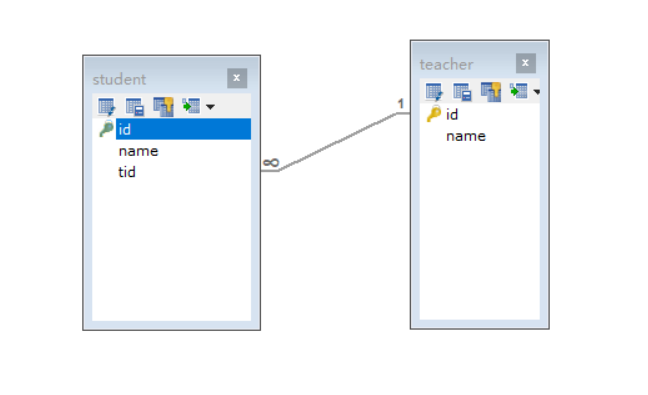
SQL:
测试环境搭建
- 导入Lombok
- 新建实体类Teacher,Student
- 建立Mapper接口
- 建立Mapper.xml
- 在核心配置文件中绑定注册我们的Mapper接口或者文件
- 测试能否成功
按照查询嵌套处理
<resultMap id="StudentTeacher" type="com.bing.pojo.Student">
<result property="id" column="id"/>
<result property="name" column="name"/>
<!-- 复杂的属性,我们需要单独处理
对象:association
集合:collection
-->
<association property="teacher" column="tid" javaType="com.bing.pojo.Teacher" select="getTeacher"/>
</resultMap>
<select id="getStudent" resultMap="StudentTeacher">
select * from student
</select>
<select id="getTeacher" resultType="com.bing.pojo.Teacher">
select * from teacher where id = #{id}
</select>
按照结果嵌套处理
<select id="getStudent2" resultMap="StudentTeacher2">
select s.id sid, s.name sname, t.name tname
from student s,
teacher t
where s.tid = t.id
</select>
<resultMap id="StudentTeacher2" type="com.bing.pojo.Student">
<result property="id" column="sid"/>
<result property="name" column="sname"/>
<association property="teacher" javaType="com.bing.pojo.Teacher" >
<result property="name" column="tname"/>
</association>
</resultMap>
MySQL多对一查询方式
- 子查询
- 链表查询
11、一对多
例如:老师对应多个学生
按照结果嵌套查询
<select id="getTeacher" resultMap="TeacherStudent">
select s.id sid, s.name sname, t.name tname, t.id tid
from teacher t,
student s
where s.tid = t.id
and t.id = #{tid}
</select>
<resultMap id="TeacherStudent" type="com.bing.pojo.Teacher">
<result property="id" column="tid"/>
<result property="name" column="tname"/>
<collection property="students" ofType="com.bing.pojo.Student">
<result property="id" column="sid"/>
<result property="name" column="sname"/>
<result property="tid" column="tid"/>
</collection>
</resultMap>
按照查询嵌套
<select id="getTeacher2" resultMap="TeacherStudent2">
select *
from teacher
where id = #{tid}
</select>
<resultMap id="TeacherStudent2" type="com.bing.pojo.Teacher">
<collection property="students" javaType="ArrayList" ofType="com.bing.pojo.Student" column="id"
select="getStudentByTeacherId">
</collection>
</resultMap>
<select id="getStudentByTeacherId" resultType="com.bing.pojo.Student">
select *
from student
where tid = #{tid}
</select>
- 关联-association 【多对一】
- 集合-collection 【一对多】
- JavaType & ofType
- JavaType用来指定实体类中的类型
- ofType用来指定映射到List或者集合中的POJO类型,泛型中的约束类型
注意:
- 保证SQL的可读性,尽量保证通俗易懂
- 注意一对多和多对一中属性名和字段的问题
- 如果问题不好排查,建议用Log4J
12、动态 SQL
什么是动态 SQL:动态 SQL就是指根据不同的条件生成不同的SQL语句
如果你之前用过 JSTL 或任何基于类 XML 语言的文本处理器,你对动态 SQL 元素可能会感觉似曾相识。在 MyBatis 之前的版本中,需要花时间了解大量的元素。借助功能强大的基于 OGNL 的表达式,MyBatis 3 替换了之前的大部分元素,大大精简了元素种类,现在要学习的元素种类比原来的一半还要少。
if
choose (when, otherwise)
trim (where, set)
foreach
搭建环境
编写数据库
创建工程
- 导入包
- 修改配置文件
- 编写实体类
IF
<select id="queryBlogIF" parameterType="map" resultType="com.bing.pojo.Blog">
select * from mybatis.blog where 1=1
<if test="title!=null ">
and title =#{title}
</if>
<if test="author!=null">
and aothor =#{aothor}
</if>
</select>
choose (when, otherwise)
<select id="queryBlogChoose" resultType="com.bing.pojo.Blog" parameterType="map">
select * from mybatis.blog
<where>
<choose>
<when test="title != null">
title =#{title}
</when>
<when test="author != null">
and author=#{author}
</when>
<otherwise>
and views=#{views}
</otherwise>
</choose>
</where>
</select>
trim (where, set)
<update id="updateBook" parameterType="map">
update blog
<set>
<if test="title!=null">
title=#{title},
</if>
<if test="author!=null">
author=#{author}
</if>
</set>
where id=#{id}
</update>
SQL片段
使用SQL标签抽取公共部分
<sql id="if-title">
<if test="title!=null ">
and title =#{title}
</if>
<if test="author!=null">
and author =#{author}
</if>
</sql>
在需要使用地方使用include标签
select * from mybatis.blog
<where>
<include refid="if-title"></include>
</where>
foreach
<select id="queryBlogForeach" resultType="com.bing.pojo.Blog" parameterType="map">
select * from blog
<where>
<foreach collection="ids" item="id" open="and (" close=")" separator="or">
id=#{id}
</foreach>
</where>
</select>
@Test
public void TestForEach(){
SqlSession sqlSession = MybatisUtils.getSqlSession();
BiogMapper mapper = sqlSession.getMapper(BiogMapper.class);
HashMap map = new HashMap();
ArrayList<Integer> ids = new ArrayList<Integer>();
ids.add(1);
ids.add(2);
ids.add(3);
map.put("ids",ids);
List<Blog> blogs = mapper.queryBlogForeach(map);
for (Blog blog : blogs) {
System.out.println(blog);
}
sqlSession.close();
}
动态SQL就是在拼接SQL语句,我们只要保证SQL的正确性,按照SQL的格式,去排列组合就好了
MySQL引擎
INNODB底层原理
索引
索引优化
13、缓存
查询:连接数据库,耗资源
一次查询的结果,给它暂存在一个可以直接取到的地方!-->内存:缓存
我们再次查询直接走缓存,就快很多
13.1、介绍
1.什么是缓存 (读写分离,主从复制)
- 存放内存中的临时数据
- 将用户经常查询的数据放入缓存,用户去查询数据就不用从磁盘上(关系型数据库数据文件)查询,从缓存中查询,从而提高工作的效率,解决了高并发系统的性能问题
2.为什么要使用缓存?
- 减少和数据库的交互次数,减少系统开销,提高系统效率
3.什么样的数据能使用缓存
- 经常查询并且不经常改变的数据
13.2Mybatis缓存
- Mybatis包含一个非常强大的查询缓存特性,它可以非常方便地定制和配置缓存,缓存可以极大的提升查询效率
- Mybatis系统默认定义了两级缓存:一级缓存和二级缓存
- 默认情况下,只有一级缓存开启(Sqlsession级别的缓存,也称为本地缓存)
- 二级缓存需要手动开启和配置,它基于namespace级别的缓存
- 未了提高扩展性,Mybatis定义了缓存接口Cache。我们可以通过实现Cache接口来实现自定义二级缓存
13.3、一级缓存
- 一级缓存也叫本地缓存 SqlSession 默认是开启的
- 与数据库同一次会话期间查询到的数据会放在本地缓存中
- 以后如果徐获得相同的数据直接从缓存中拿,没必要再去查询数据库
测试:
1.开启日志
2.测试在一个SqlSession中查询两次相同记录
3.查看结果
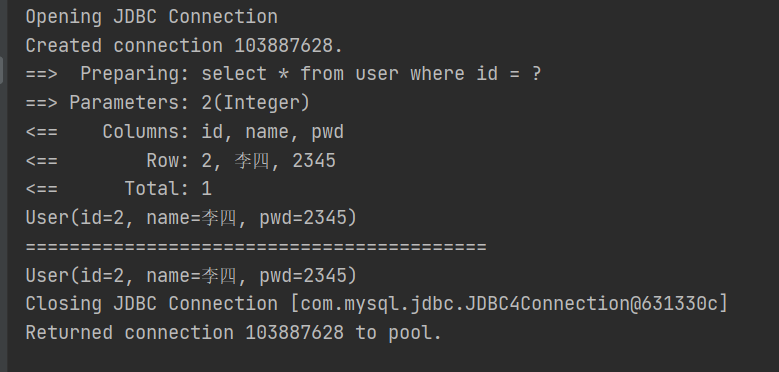
缓存失效:
- 执行增删改都会失效
- 手动清理
一级缓存就是一个map
13.4、二级缓存
- 二级缓存也叫全局缓存,一级缓存作用域,所以使用二级缓存
- 基于namespace级别的缓存,一个命名框架,对应一个二级缓存
- 工作机制
- 一个会话查询一条数据,这个数据就会被放在当前会话的一级缓存中
- 如果当前会关闭,这个会话对应的一级缓存也就清理了,但是我们香要的是,就算会话关闭了,一级缓存中的数据保存的二级缓存中
- 新的会话查询信息,就可以直接从二级缓存中拿到
- 不同的maooer查处的数据会放在自己对应的缓存(map)中
步骤:
-
开启全局缓存
<!--开启全局缓存--> <setting name="cacheEnabled" value="true"/> -
在需要开启的地方使用自定义参数
<!-- 在当前Mapper.xml文件中使用二级缓存 --> <cache eviction="FIFO" flushInterval="60000" size="512" readOnly="true"/> -
测试
-
问题:我们徐将实体类序列化,否则会报错
public class User implements Serializable
-
小结:
- 只要开启二级缓存,在同一个Mapper下就有效
- 所有的数据都会先放在一个一级缓存中
- 只有当会话提交,或者关闭,一级缓存中的数据才会被放到二级缓存中
13.5、缓存的原理
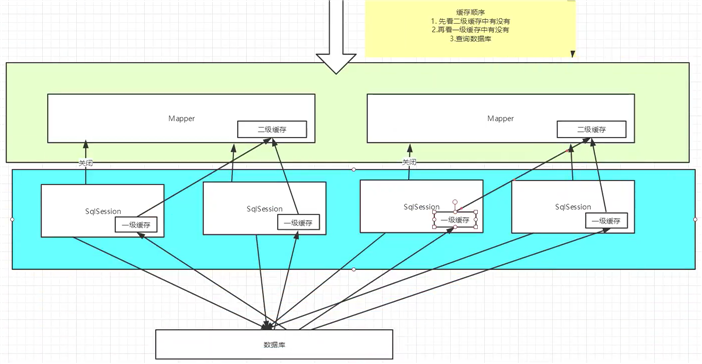
13.6、自定义缓存-EhCache
Ehcache是一种广泛使用的开源Java分布式缓存。主要面向通用缓存,Java EE和轻量级容器。
<cache type="org.mybatis.caches.ehcache.EhcacheCache"/>
